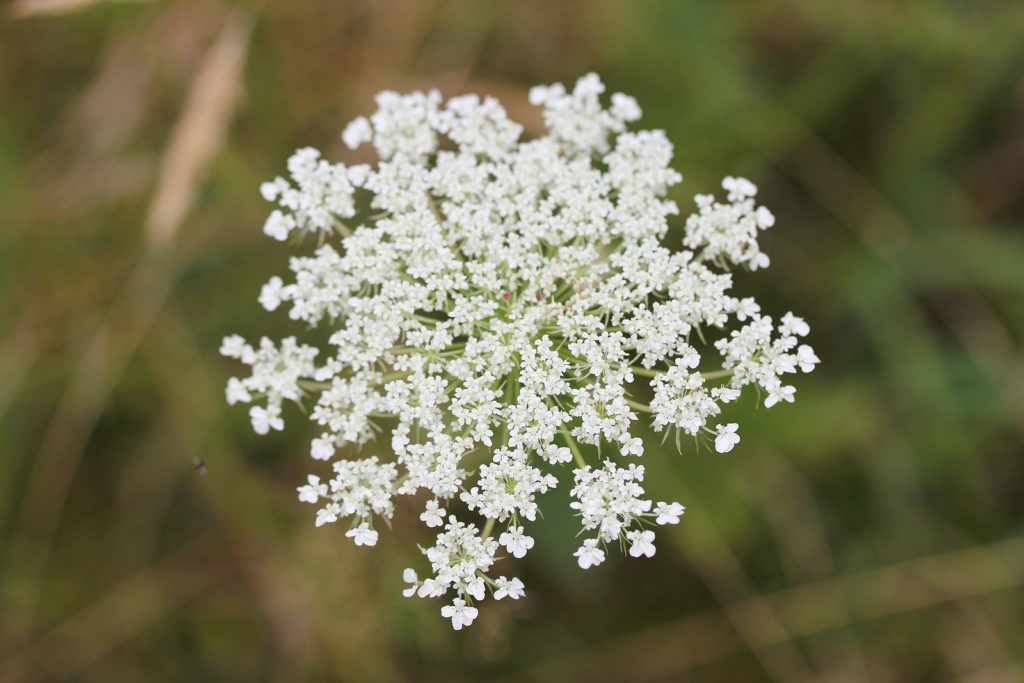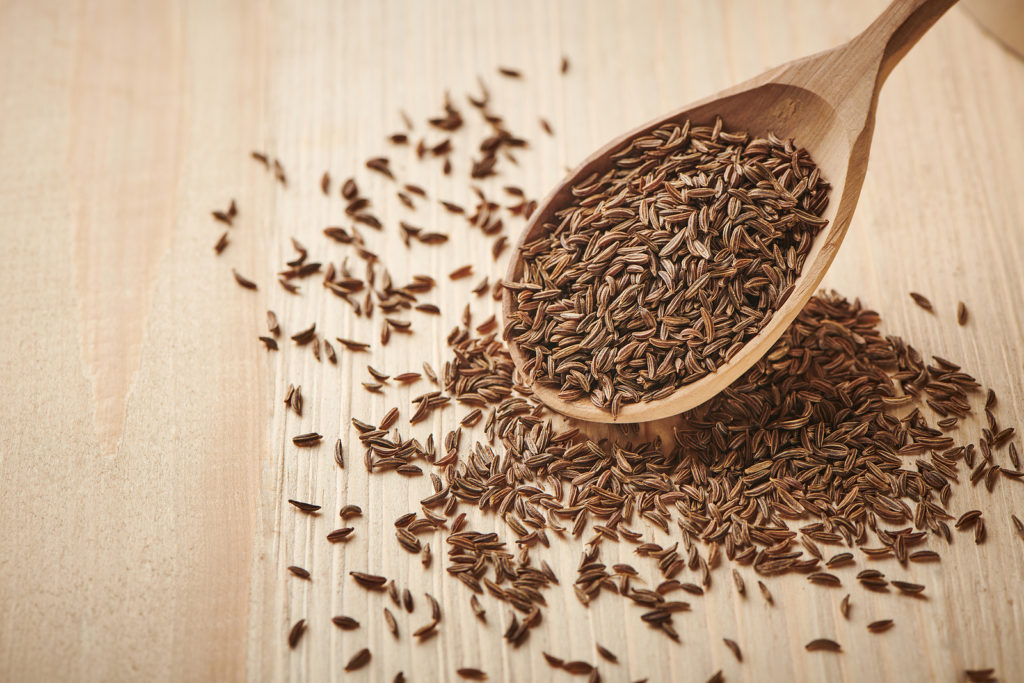Caraway is often grown for its thin, crescent-shaped seeds but all parts of the caraway plant are edible—leaves, stems, seeds, and roots. Caraway is a biennial that produces carrot-like leaves the first year and flower heads and seeds the second year. The flavor of caraway leaves and seeds is earthy, with a hint of citrus and pepper.
Here is your complete guide to growing caraway.
Where to plant caraway
- Best location: Plant caraway in full sun; it will tolerate partial shade.
- Soil preparation: Caraway grows best in well-drained sandy soil. It prefers a soil pH of 6.0 to 7.0. Add aged compost to planting beds in advance of planting. Caraway will grow in average soil as well.

When to plant caraway
- Seed starting indoors: Sow caraway indoors in biodegradable peat pots or cell packs 3 to 4 weeks before the average last frost for transplanting out both pot and plant later. Press seed into the potting soil surface and cover lightly with vermiculite. Seed germinates in 4 to 14 days.
- Transplanting to the garden: Set caraway seedlings in the garden shortly after the last spring frost.
- Outdoor planting time: Sow caraway outdoors in spring or autumn. For an early start, sow caraway in spring as early as the soil can be worked, about the date of the average last frost. Sow seed shallowly. Seeds sown in spring will not produce flowers or seeds until the second summer. You can also sow seeds in autumn for germination the next spring.
How to plant caraway
- Planting depth: Sow caraway seed ¼ inch deep.
- Spacing: Space plants 8 inches apart. Thin successful plants from 12 to 18 inches apart when seedlings are about 4 inches tall. Space rows 18 to 24 inches apart.
- How much to plant: Grow 6 caraway plants for cooking; grow 12 plants for preserving.
Caraway companion plants
- Companion plants: Caraway grows well with most vegetables. It does not grow well near sweet fennel. It is a good companion to peas. Caraway flowers attract beneficial insects including predatory wasps that attack tomato hornworms.
Watering and feeding caraway
- Watering: Caraway requires regular, even watering until established. Do not allow seedlings to dry out. Once established, caraway can go nearly dry between waterings. Stop watering when flowers begin to form; this will encourage seeds to mature more quickly.
- Feeding: Fertilize caraway lightly when seedlings are 3 inches tall and again when flower shoots appear. Give caraway a side dressing of aged compost at midseason.

Caraway care and maintenance
- Care: Avoid excessive pruning in the first year or the plant may be weakened. In cold-winter regions, caraway may need winter protection in order to produce flowers and seeds the second year. Pinch away flowers in the second year, and caraway will grow for another season.
- Mulching: If the soil freezes in winter cover plants with leaf mold, straw, or aged compost to protect the roots.
Container growing caraway
- Container growing: Select a container at least 8 inches deep. Caraway has a taproot and does not grow very well in a container.
Caraway pests and diseases
- Caraway is a member of the carrot and parsley family and so is susceptible to the same pests and diseases as carrots and parsley; it’s best to plant these crops away from each other.
- Pests: Caraway may be attacked by parsley caterpillars and aphids. Handpick caterpillars off the plant and drop them in a can of soapy water. You can also spray caterpillars with Bacillus thuringiensis. Knock aphids off plants with a steady stream of water.
- Diseases: Aster yellows virus can attack caraway and cause flowers to lose their color and become malformed. Aster yellows virus is spread by leafhoppers. Control leafhoppers with neem oil.
How to harvest caraway
- When to harvest: Snip caraway leaves from spring onward the first year for fresh use. Harvest seeds the second year after flowering but before seeds fall to the ground. Cut flower heads as seeds turn from yellowish to brown. Harvest roots as soon as flowering is finished.
- How to harvest: Allow seeds to dry out and turn brown. Place a paper bag around seed heads; seeds will drop into the bag as they ripen. Complete the harvest before the frost.
Caraway in the kitchen
- All parts of the caraway plant are edible.
- Flavor and aroma: Seeds taste earthy, with a hint of citrus and pepper.
- Leaves: Add young leaves to fruit and green salads, cheeses, butter, and also to soups and stews.
- Seeds: Lightly toasted seeds can be used whole or ground to flavor bread, cakes, cookies, soups, sauces, stews, pork, beef, vegetables, cheeses, eggs, and apples. Use seeds to flavor pickles, cabbage, Brussels sprouts, cauliflower, and rye bread.
- Chew seeds to relieve indigestion.
- Roots: The taproot which looks like a white carrot is edible. Roots are eaten as a winter vegetable much like parsnip—steamed or chopped into soups or stews.

Preserving and storing caraway
- Refrigeration: Caraway leaves are best used fresh, but they can be stored in the refrigerator for a few weeks wrapped in a damp paper towel, and placed in a plastic bag.
- Drying: Hang stems upside down with seed heads in a paper bag to catch seeds as they fall. Dry seedheads in a cool place for about 10 days. Sift seeds through a ¼-inch mesh to remove the chaff.
- Storing: Dry seeds can be stored for several months in an airtight container.
Caraway propagation
- Seed: Caraway is easily grown from seed; it will reseed itself easily in most areas.
- Cuttings: Start new plants from cuttings taken from new growth in summer or fall.
Get to know caraway
- Botanical name and family: Carum carvi (Apiaceae —carrot family)
- Europe
- Type of plant: Caraway is a biennial herb.
- Growing season: Summer to fall.
- Growing zones: Caraway grows best in Zones 3 to 11
- Hardiness: Caraway tolerates both cold and heat; it’s hardy to -30°
- Plant form and size: Caraway grows 12 to 30 inches tall and half again as wide. The foliage has a mounded form the first year; in the second year, flowering stalks elongate to rise above the mound.
- Flowers: Caraway produces umbrella-like clusters of white and pink flowers.
- Bloom time: Caraway flowers in spring and early summer of the second year on 2-foot stems.
- Seeds: A month or so after flowers fade, small tasty seeds ripen and can be collected just before the plant begins to fade and die.
- Leaves: Caraway has glossy, bright green, finely cut leaves that resemble carrot leaves. Leaves grow on floppy stems from a short rosette. Leaves form in a mound 2 feet high the first year; leaves die to the ground in the fall. Leaves reappear in spring followed by flowers in early summer.
Related articles:
- Anise
- Anise Hyssop
- Arugula
- Basil
- Bay
- Bee Balm
- Borage
- Calendula
- Caraway
- Catnip
- Chamomile
- Chervil
- Chives
- Cilantro-Coriander
- Clary
- Costmary
- Cress
- Dill
- Fennel, Sweet
- Horseradish
- Hyssop
- Lavender
- Lemon Balm
- Lemon Verbena
- Lovage
- Marjoram
- Mint
- Nasturtium
- Oregano
- Parsley
- Perilla
- Rosemary
- Sage
- Salad Burnet
- Savory
- Scented Geranium
- Shiso
- Sorrel
- Stevia
- Sweet Cicely
- Tarragon
- Thyme
Best Herbs for Container Growing
Planning the Home Fruit Garden
Garden Planning Books at Amazon:
- Vegetable Garden Almanac & Planner
- Kitchen Garden Grower’s Guide Vegetable Encyclopedia
- Vegetable Garden Grower’s Guide
- Tomato Grower’s Answer Book



